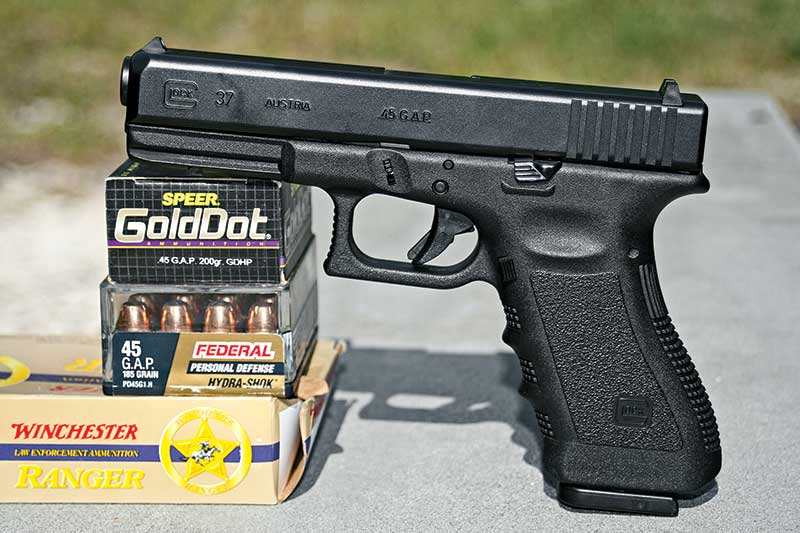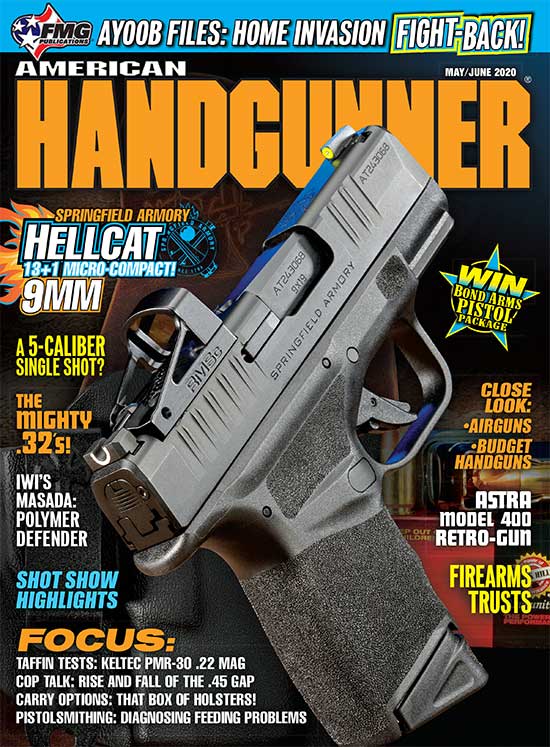the rise and fall
of the .45 GAP
In 2003, a joint effort by GLOCK and an ATK team led by the brilliant Ernest Durham birthed the .45 GAP cartridge. GLOCK’s 13+1 round G21 had, in 13 years, become the most popular standard issue .45 ACP among America’s police, but smaller-handed personnel complained of its girth and long trigger reach. The .45 GLOCK Auto Pistol cartridge came in at a size that could run in 9mm-size platforms: OAL 1.070″ and a case length of 0.755″. This allowed its use in the standard GLOCK frame as opposed to the larger one developed for the .45 ACP and 10mm Auto.
New York State Police were the first big agency to adopt it. Soon 10 percent of our state police agencies had armed their troopers with the GAP, including Pennsylvania, Georgia, South Carolina and Florida. All reported excellent results in actual shootings. Other ammo makers offered .45 GAP, with a choice of 185-, 200- and 230-gr. rounds fully duplicating standard pressure .45 ACP performance. Springfield Armory tooled up to make pistols for the new cartridge. The .45 GAP was on a fast track.
Today, however, 80 percent of those bellwether LE agencies have abandoned it. Half of those, PA and NY, went back to .45 ACP, while the other half, GA and SC, went to the 9mm. What happened? There’s more than one answer.
Confluence Of Trends
Some on the Internet speculated the GAP was an ingenious solution to a non-existent problem, or a sop to Gaston Glock’s vanity. The facts show otherwise. Testing by prestigious agencies like FHP showed the G37 in .45 GAP was easier for small-handed officers to shoot, and larger-handed officers shot better with it than with the big G21. However, some other things were going on, creating a perfect storm causing the new cartridge to founder in popularity.
Competing .45 ACPs came out, including GLOCK’s own, that were easier to grasp. The Smith & Wesson M&P had a slimmer grip-frame and shorter trigger reach, as did the Springfield Armory XD45, the first achieved with a 10-round magazine and the second with a 13-rounder in a longer grip-frame. In-house, GLOCK had made two changes to allow more ergonomic grasping of their own 13+1 round G21 .45 ACP: the SF (for Short Frame) series, and the Gen4 .45’s. In essence, GLOCK’s own .45 ACPs were making their .45 GAPs redundant.
Ammo droughts had disparate impact on the less common calibers. Remember 2012, when ammo shelves were bare and people queued up at WalMart to buy their two rationed boxes of 9mm or .22 on ammo delivery day? That hit the police market, too, with departments waiting many months for delivery of duty and training ammo in even the most popular calibers. Consequently 9mm, .40 S&W and .45 ACP got priority on the production lines; .357 SIG, 10mm, and yes, .45 GAP were sort of “we’ll make some when we get caught up.” The waits were even longer for cartridges in the .45 GAP’s “new kid on the block” level of use.
More Bang
fostered by FBI and the ammo companies, the trope of “new ammo developments have made 9mm equal to the larger calibers” flourished in both the armed citizen and police sectors. While improved ammo certainly helped the 9mm to a greater extent than it did more powerful rounds, what was undeniable was 9mm was easier to shoot, cheaper to buy, and more readily available by far than .45 GAP. There was also the on-board firepower element. Within the space of a standard frame GLOCK’s magazine, a department like SCHP or Georgia State Patrol went from 10+1 .45 GAP rounds in-gun to 17+1 rounds of 9mm when they swapped their G37s for G17s.
What none of the departments that dumped the .45 GAP complained about was so-called “stopping power.” Without exception, they were pleased with how fast solid hits with good JHPs from the .45 GAP stopped violent encounters.
Though it’s fading, the .45 GAP isn’t gone. It remains an extremely viable choice for the user who wants the reassurance of the proven .45 caliber bullet, and a pistol fitting most hands well — can keep a goodly stock of ammo in their armory.






